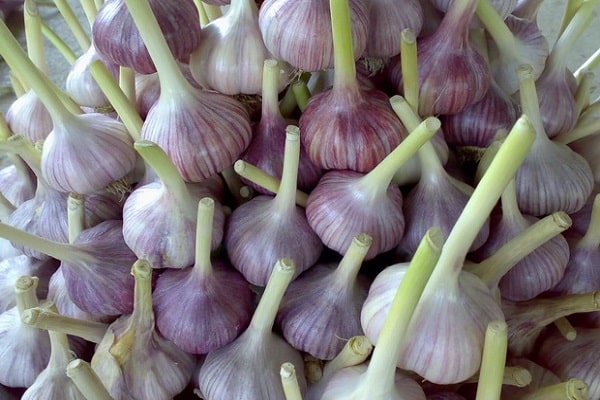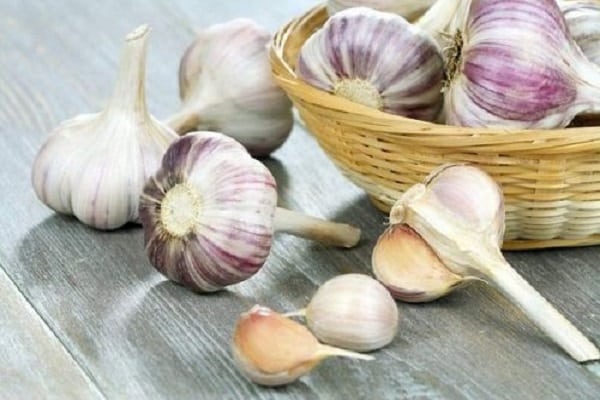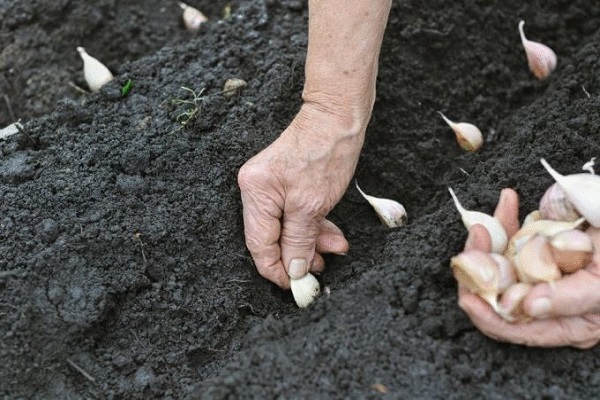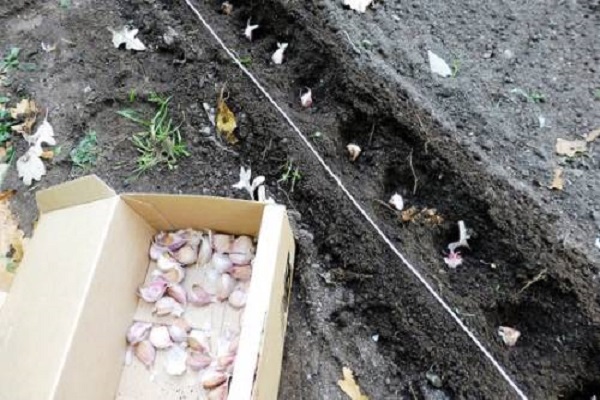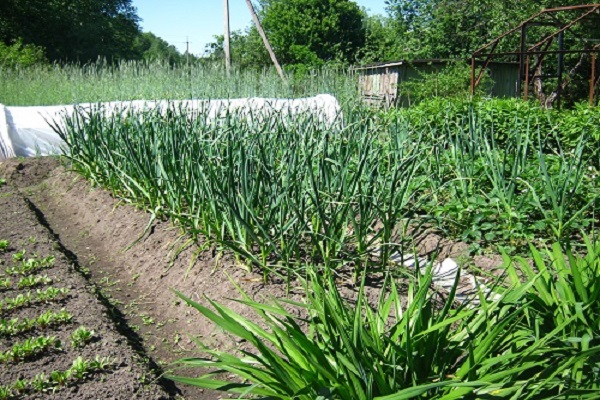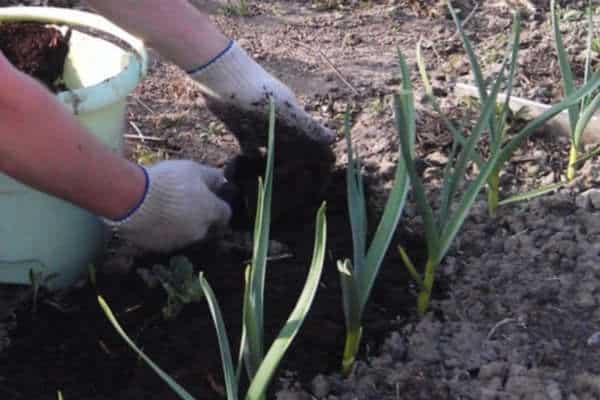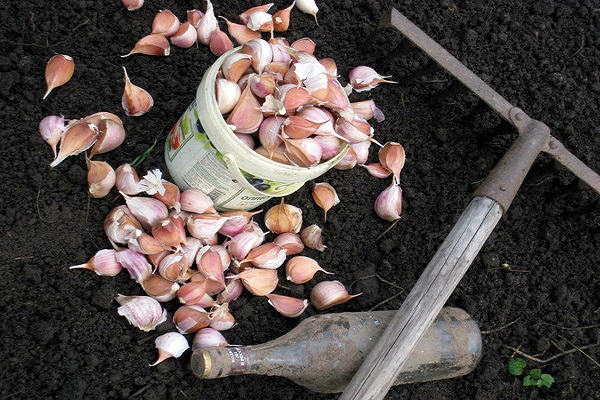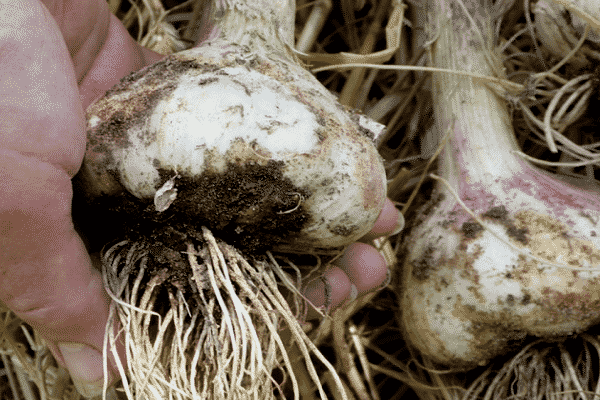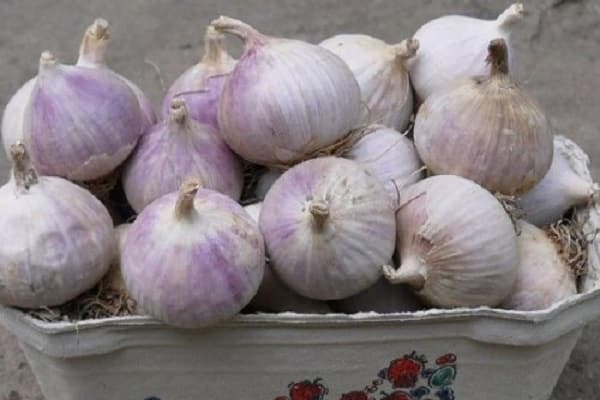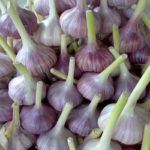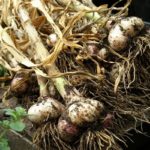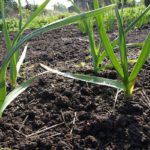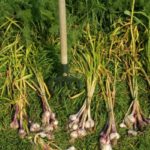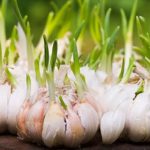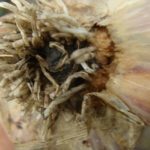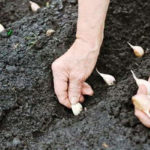The Skif variety of garlic has gained popularity among Russian gardeners, and if you want to try growing the crop yourself, gardeners advise paying attention to it. Garlic is an indispensable ingredient for many culinary recipes. For humans, regular consumption of such a product has a beneficial effect on the functioning of the immune system and the entire body, which is due to the high content of useful substances in garlic.
Description of the variety
The winter garlic variety Skif was the result of West Siberian selection.The crop belongs to a variety of mid-season species and is characterized by good yield indicators. The heads are designed for universal use. Fresh cloves have a pungent taste, each clove has a pronounced garlic aroma.
The culture of varietal garlic forms arrows when grown. The leaves are 2.2 cm wide and 43 cm long. The plates are green with a slight bluish tint. Their average number varies from 6 to 7. Description of garlic heads:
- the bulbs have a round shape;
- the average weight of one fruit is 30 grams, individual specimens reach a weight of 50 grams;
- on average, 1 head contains from 4 to 5 dense teeth with a blunt end, having a simple structure and large size.
On average, the surface of garlic cloves contains from 3 to 4 scaly layers of white color with a slight tint of lilac color. On the outer surface of the adult head you can see a network of small vessels and purple veins; the denticles are closely adjacent to each other.
The variety shows good yield indicators and when grown on an industrial scale, up to 6.6 tons of garlic are obtained from 1 hectare. When grown on a personal plot with 1 m2 get 0.7-0.8 kg.
Growing
The characteristics of the winter variety indicate planting in the central regions from early to mid-October. In northern regions with a cold climate, work is carried out in early autumn. After planting, the cloves need time to germinate and form a root system. Otherwise, the plant will not acquire the proper quality of frost resistance.
Before planting, the cloves are sorted, selecting only strong and healthy cloves without defects, signs of mold or putrefactive damage. If one of the cloves in one head is damaged, then the entire onion is rejected. After selection, the planting material is soaked for 6 minutes in Fitosporin for disinfection, which will increase the protective properties of the plant.
Before planting, the soil is mulched with a thick layer to provide additional soil insulation and reduce garlic loss. For this you can use the following materials:
- humus;
- peat;
- ready compost.
The planting time is determined so that on average there is 1.5 months left before the onset of cold weather. The soil temperature should be 10-15 0C. Planting is carried out in grooves with a depth of 5 to 10 cm, the distance between rows is 20-25 cm, between cloves is from 5 to 7 cm. Sand and ash are first added to the furrows.
Features of care
The planting site should be sunny and well ventilated. When spring comes, there should be no flooding in the selected area. After planting, winter varieties are not watered. The plant feels good after the following predecessors:
- cabbage;
- tomatoes;
- zucchini;
- cucumbers;
- legumes
The first entries of winter garlic Skif appear in early spring. The time until the film of the inflorescences cracks is 98-108 days. Full ripening occurs in early July. After warming up the soil to 10 0The place of permanent cultivation is loosened. If spring is dry, then garlic requires watering once every 7 days.
Winter garlic is undemanding to growing conditions and plant care techniques are standard.Plantings require timely watering and weeding. After the shoots grow 10 cm long, they need to be removed, which will increase the yield by 30-40%.
As the plant grows, it forms an arrow on which inflorescences subsequently ripen. The bulbs are characterized by their small size and delicate purple hue. Their number in one plant can reach 150. If desired, they can be used as planting material, for which 5 to 6 garlic shoots are left on one plant.
Advantages and disadvantages
The advantage of the winter variety is its high content of nutrients. The plant tolerates frost and low temperatures well in winter. A distinctive quality is high yield rates. The only drawback can be considered the lack of ability of the heads for long-term storage.
Pests and diseases
Skif is considered a variety resistant to most garlic diseases. The plant is slightly susceptible to bacteriosis and white rot. To prevent infection, the landing site should be carefully inspected and the landing zones should be changed periodically.
To prevent infection of the heads with root mites, it is recommended to fumigate the planting site with sulfur dioxide or treat it with chloropicrin. All waste after harvesting is completely burned.
Weakened plants are most susceptible to diseases. During the growing season, the presence of negative changes can be recognized by the appearance of garlic:
- difficult formation of feathers - the plant is experiencing a deficiency of nutrients, it is necessary to fertilize;
- the presence of bluish-white arrows is evidence of insufficient watering;
- pale green color of the leaves - you need to reduce the amount of watering.
The most difficult thing is to determine the cause of yellowing leaves. The reason may be excess moisture, freezing of the plant, unsuitable soil or exposure to pests.
Harvest and storage
A distinctive feature of winter varieties of garlic is the short shelf life of the heads. Feedback from gardeners suggests that after harvesting the bulbs should be consumed first, and only then use spring varieties.
After harvesting, the garlic heads are thoroughly dried and placed in a cool, dark place. At the same time, the benefits of the winter variety compared to spring crops are much greater, since it contains a higher content of glycosides, thanks to which the cloves have a sharper and richer taste.
Reviews from gardeners
Anastasia, 43 years old:
“Skif is one of the most favorite types of garlic. It produces stable yields for several years and can be used for fresh eating by lovers of garlic dishes. I choose winter varieties because there is an opportunity to do some quiet planting after finishing the main gardening work.”
Lyudmila, 53 years old:
“Skif should be grown for use in food or salting. I consider the distinctive quality of garlic to be its medium-hot taste and high juiciness of the cloves. This variety is not suitable for long-term storage, but the bulbs can last until mid-December.”

